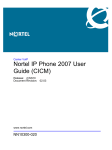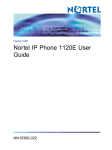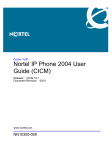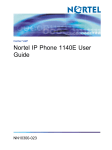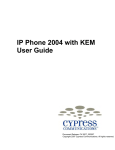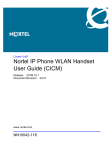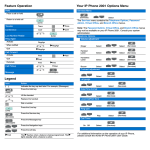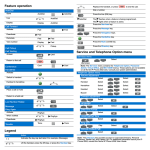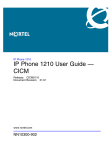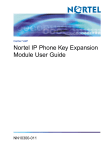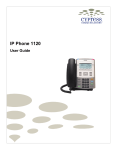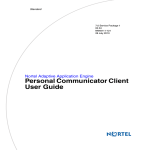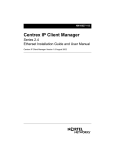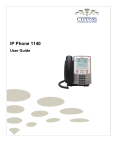Download Nortel Networks IP Phone 2001 User's Manual
Transcript
Carrier VoIP Nortel IP Phone 2001 User Guide (CICM) Release: CICM 10.1 Document Revision: 09.01 www.nortel.com NN10300-005 . Carrier VoIP Release: CICM 10.1 Publication: NN10300-005 Document status: Standard Document release date: 4 July 2008 Copyright © 2008 Nortel Networks All Rights Reserved. Printed in Canada, the United States of America, and the United Kingdom LEGAL NOTICE While the information in this document is believed to be accurate and reliable, except as otherwise expressly agreed to in writing NORTEL PROVIDES THIS DOCUMENT "AS IS" WITHOUT WARRANTY OR CONDITION OF ANY KIND, EITHER EXPRESS OR IMPLIED. The information and/or products described in this document are subject to change without notice. Nortel, the Nortel logo, Business Made Simple and the Globemark are trademarks of Nortel. All other trademarks are the property of their respective owners. . 3 . Contents New in this release Features 7 Other changes 7 7 Overview 9 Basic features 9 Terminal display 10 IP Phone 2001 menu systems 11 Call Services menu 13 Settings menu 13 Regional menu 13 User menu 14 Terminal menu 14 Call menu 14 Softkey Status 14 Connecting the IP Phone 2001 components 15 Logging on 17 Logging off 19 Making calls 21 Making a call using off-hook dialing 21 Making a call using hands-free dialing 21 Make a call using predial 22 Editing a predialed number 22 Answering a call 25 Terminating a call 27 Navigating the menu system 29 Navigating the Navigating the Navigating the Navigating the Main menu 29 Call Services menu 30 Settings menu 30 Regional menu 31 Carrier VoIP Nortel IP Phone 2001 User Guide (CICM) NN10300-005 09.01 Standard 4 July 2008 Copyright © 2008 Nortel Networks . 4 Navigating the Navigating the Navigating the Navigating the Navigating the User menu 31 Terminal menu 32 Call menu 32 Feature menu 33 Directory menu 34 Using the Call Services menu 35 Activating a feature from the menu 35 Using a soft key to activate a feature 36 Assigning a feature to a soft key 36 Removing a feature assignment from a soft key 37 Resetting soft keys to the default 37 Viewing soft key assignments 38 Displaying soft key labels while on a call 38 Hiding soft key labels 39 Viewing feature profiles 39 Labeling soft keys 40 Using the Regional menu 41 Selecting the language 41 Selecting the time zone 42 Enabling Daylight Saving time 42 Disabling Daylight Saving time 43 Defining the time format 44 Defining the date format 45 Resetting the default time 46 Using the User menu 47 Viewing your user name 47 Viewing your login type 47 Viewing, disabling, or enabling Auto Login 48 Changing your password 49 Using the Terminal menu 51 Viewing and editing your audio profile 51 Viewing and editing the default volume 52 Adjusting the contrast level of the display 53 Performing a firmware upgrade 54 Viewing and editing the dialpad feedback 55 Call menu 57 Accessing the Feature menu 57 Resetting the Inbox or Outbox 57 Resetting soft keys to the defaults 58 Using the Feature menu Using the Assign menu 61 Carrier VoIP Nortel IP Phone 2001 User Guide (CICM) NN10300-005 09.01 Standard 4 July 2008 Copyright © 2008 Nortel Networks . 61 5 Defining the Key type 62 Enabling or disabling AutoScroll 63 Resetting the feature keys to the defaults 63 Labeling a feature 64 Using the Options menu 65 Enabling or disabling Auto Hide 65 Defining your default feature 66 Assigning the Outbox to a key 66 Using the Directory menu 69 Adding an entry to the directory 69 Editing a directory entry 70 Deleting an entry from the directory 71 Making a call using the directory 72 Using the Inbox 73 Accessing the Inbox 73 Viewing Inbox call information 74 Storing a number from the Inbox 74 Using the Inbox to make a call 75 Using the Outbox 77 Accessing the Outbox 77 Viewing Outbox call information 78 Storing a number from the Outbox 78 Using the Outbox to make a call 79 Call Services 81 Call Services menu 81 Feature profiles 81 Soft key assignment 82 Examples of feature to soft key mapping 83 Mute feature 87 Inbox 89 Outbox 91 Using the dialpad to enter text 93 Use the IP Phone 2001 with the IP Softphone m6350 95 Access Code summary 97 Carrier VoIP Nortel IP Phone 2001 User Guide (CICM) NN10300-005 09.01 Standard 4 July 2008 Copyright © 2008 Nortel Networks . 6 Carrier VoIP Nortel IP Phone 2001 User Guide (CICM) NN10300-005 09.01 Standard 4 July 2008 Copyright © 2008 Nortel Networks . 7 . New in this release Features There were no feature changes made to this document. Other changes There were no other changes made to this document. Carrier VoIP Nortel IP Phone 2001 User Guide (CICM) NN10300-005 09.01 Standard 4 July 2008 Copyright © 2008 Nortel Networks . 8 New in this release Carrier VoIP Nortel IP Phone 2001 User Guide (CICM) NN10300-005 09.01 Standard 4 July 2008 Copyright © 2008 Nortel Networks . 9 . Overview The IP Phone 2001 brings voice and data to the desktop by connecting directly to a Local Area Network (LAN) through an Ethernet connection. Basic features The IP Phone 2001 supports these features: • • • • • four soft keys multifield LCD screen speaker for on-hook dialing or on-hook listening volume control bar for adjusting ringer, speaker and handset volume two specialized fixed keys: — Services — Inbox • three Call processing fixed keys: — Line — Hold — Goodbye • Automatic network configuration Not all features are available on all telephones. Consult your system administrator to verify which features are available to you. Figure 1 "IP Phone 2001 " (page 10) , shows the location of the keys and the components of the IP Phone 2001. Carrier VoIP Nortel IP Phone 2001 User Guide (CICM) NN10300-005 09.01 Standard 4 July 2008 Copyright © 2008 Nortel Networks . 10 Overview Figure 1 IP Phone 2001 Terminal display Figure 2 "IP Phone 2001 display" (page 10) , describes the IP Phone 2001 display areas. Figure 2 IP Phone 2001 display Carrier VoIP Nortel IP Phone 2001 User Guide (CICM) NN10300-005 09.01 Standard 4 July 2008 Copyright © 2008 Nortel Networks . 11 . IP Phone 2001 menu systems After you have successfully logged on to the IP Phone, the menu systems are active and available. Menu items, the Inbox, the Outbox, and Directory entries, are accessed through lists. An up or down arrow appears beside an item to indicate the navigation key you can press to scroll to the next item. Labels appear on the bottom row above the soft keys, in response to items selected in the display. The IP Phone menu system provides access to these menus and submenus. • • • Logoff Call Services Settings — Regional — User — Terminal — Call • • • Directory Inbox Outbox Carrier VoIP Nortel IP Phone 2001 User Guide (CICM) NN10300-005 09.01 Standard 4 July 2008 Copyright © 2008 Nortel Networks . 12 IP Phone 2001 menu systems Figure 3 IP Phone 2001 display menu hierarchy Carrier VoIP Nortel IP Phone 2001 User Guide (CICM) NN10300-005 09.01 Standard 4 July 2008 Copyright © 2008 Nortel Networks . Settings menu 13 Call Services menu The Call Services menu gives the IP Phone 2001 access to Centrex features. The soft keys in the display provide an alternative to the dedicated feature keys on an IP Phone 2004. Any changes made to the 2001 feature key assignments, through the feature menu, apply only when the user is logged on to an IP Phone 2002 or 2004, which has dedicated Feature Keys. The Call Services menu is available after you select a Centrex feature from the list and press OK. Use the Call Services menu to: • • • • • • • • Activate a feature Deactivate a feature Assign a Centrex feature to a soft key Remove a feature from a soft key Reset the soft keys to the default settings View the current soft key assignments View a feature profile Change the label associated with a soft key Settings menu The Settings menu provides access to these submenus, which allow you to configure user preferences. Regional menu Items in the Regional menu allow you to select the your language, the time zone, and the time and date format the terminal uses; or to reset these terminal settings to their defaults. Use the Regional menu to configure: • • Language preference Time format which allows you to configure the following: — Time zone — Enable or disable Daylight Saving Time — Select the format used to display the time — Select the format used to display the date — Reset the time to the defaults Carrier VoIP Nortel IP Phone 2001 User Guide (CICM) NN10300-005 09.01 Standard 4 July 2008 Copyright © 2008 Nortel Networks . 14 IP Phone 2001 menu systems User menu Use the User menu to: • • • • View your user name View your login type Enable or disable auto login feature Change your password Terminal menu Use the Terminal menu to configure your: • • • View your audio profile Adjust the contrast level of the display Performing a firmware upgrade Call menu The Call menu allows you to access these menus: • • • Feature History Softkey Softkey Status This item allows you to view the Centrex features currently assigned to the soft keys. Inbox See "Inbox" (page 89). Outbox To use this feature you must assign the Outbox to a Directory Number (DN) key. See "Outbox" (page 91). Directory To use this feature, you must assign the Directory to a DN key. After you assign a DN key to the Directory, use the Directory menu to: • • • • Add an entry to the directory Edit a directory entry Delete an entry from the directory Make a call using the directory Carrier VoIP Nortel IP Phone 2001 User Guide (CICM) NN10300-005 09.01 Standard 4 July 2008 Copyright © 2008 Nortel Networks . 15 . Connecting the IP Phone 2001 components Follow this procedure to connect the handset to the terminal, and to connect the terminal to the LAN, and to a power source. CAUTION Risk of equipment damage Do not plug the IP Phone 2001 into a regular telephone jack. This causes severe damage to the terminal. Consult your system administrator to ensure that you plug your telephone into a 10/100BaseT Ethernet jack. See Figure 4 "IP Phone 2001 connectors" (page 16) , for the location of the connectors. Procedure Steps Step Action 1 Connect one end of the handset cord to the handset jack (identified with a handset icon) on the underside of the terminal. 2 Connect the other end of the handset cord the jack on the handset. 3 Connect one end of the CAT-5 line cable to the LAN Ethernet port (identified with a LAN icon), located on the underside of the terminal. 4 Plug the other end of the CAT-5 line cable into the IP network. 5 Contact your installation technician for the proper power option. The IP Phone 2001 can be powered by an AC adapter, or over a LAN. 6 Thread the cord around the strain relief, retaining hook and channel provided for a secure power connection. 7 Secure the terminal footstand to the base. --End-- Carrier VoIP Nortel IP Phone 2001 User Guide (CICM) NN10300-005 09.01 Standard 4 July 2008 Copyright © 2008 Nortel Networks . 16 Connecting the IP Phone 2001 components Procedure job aid This figure shows the location of the connectors on the back of the IP Phone 2001 terminal. Figure 4 IP Phone 2001 connectors Carrier VoIP Nortel IP Phone 2001 User Guide (CICM) NN10300-005 09.01 Standard 4 July 2008 Copyright © 2008 Nortel Networks . 17 . Logging on Follow this procedure to log on to an IP Phone 2001. If the Centrex IP Client Manager (CICM) is set up as part of a group of CICMs, you can choose which CICM to connect to. After you select a gateway, the terminal directs itself to that CICM and the Username screen appears. If a firmware upgrade for the IP Phone 2001 is available, the system prompts you to upgrade when you log on. If the terminal is below the minimum level, the only option available is Yes. You cannot log on until you perform the upgrade. If the firmware level is between the minimum and maximum level set by the administrator, Yes and No options appear on the soft keys. To perform an upgrade, see "Performing a firmware upgrade" (page 54). Procedure Steps Step Action 1 If the Selective Gateway Login feature is configured on your system, press the down navigation key to scroll through the list to select the gateway. 2 When the gateway you want appears, press Ok, or start entering your user name. If the Username Screen appears when you start to enter your user name, the characters you already entered appear in the Username field. 3 If you make a mistake entering your user name, press Clear to clear the field and re-enter your user name. If your user name is too long for the display (longer than 15 characters), the digits scroll to the left and an ellipsis appears to the left of the field. 4 Press Ok. Carrier VoIP Nortel IP Phone 2001 User Guide (CICM) NN10300-005 09.01 Standard 4 July 2008 Copyright © 2008 Nortel Networks . 18 Logging on The password screen appears. 5 Enter your password. For security, the password characters are displayed as asterisks (*). 6 If you make an error, press Clear to clear the field, and then enter your password. 7 Press Ok. You are logged on and the Menu screen appears. --End-- Carrier VoIP Nortel IP Phone 2001 User Guide (CICM) NN10300-005 09.01 Standard 4 July 2008 Copyright © 2008 Nortel Networks . 19 . Logging off Follow this procedure to log off from the network. Prerequisites You must be logged on. Procedure Steps Step Action 1 From the main menu, select Log Off. 2 Press Ok. A confirmation screen appears. 3 Press Yes. You are logged off from the network. --End-- Carrier VoIP Nortel IP Phone 2001 User Guide (CICM) NN10300-005 09.01 Standard 4 July 2008 Copyright © 2008 Nortel Networks . 20 Logging off Carrier VoIP Nortel IP Phone 2001 User Guide (CICM) NN10300-005 09.01 Standard 4 July 2008 Copyright © 2008 Nortel Networks . 21 . Making calls Follow these procedures to make calls. Navigation • • • • "Making a call using off-hook dialing" (page 21) "Making a call using hands-free dialing" (page 21) "Make a call using predial" (page 22) "Editing a predialed number" (page 22) Making a call using off-hook dialing Follow this procedure to make a call using off-hook dialing. Prerequisites You must be logged on. Procedure Steps Step Action 1 Pick up the handset. You hear a dial tone. 2 Use the dialpad to enter the number. 3 When the call is answered, lift the handset and speak into the mouthpiece. --End-- Making a call using hands-free dialing Follow this procedure to make a call using hands-free dialing. See Figure 1 "IP Phone 2001 " (page 10) , for the location of the Line key. Prerequisites You must be logged on. Carrier VoIP Nortel IP Phone 2001 User Guide (CICM) NN10300-005 09.01 Standard 4 July 2008 Copyright © 2008 Nortel Networks . 22 Making calls Procedure Steps Step Action 1 With the handset in the cradle, press the Line key on the terminal. You hear a dial tone. 2 Use the dialpad to enter the number. 3 When the call is answered, lift the handset and speak into the mouthpiece. --End-- Make a call using predial Follow this procedure to use the predial feature to make a call. Prerequisites You must be logged on. Procedure Steps Step Action 1 Use the dialpad to enter the number before you lift the handset. Do not press the Line key. The number is entered into the terminal. When you want to make the call, press Ok. 2 The number is dialed. When the call is answered, lift the handset and speak into the mouthpiece. 3 --End-- Editing a predialed number Follow this procedure to edit a number held in the predialed state. Prerequisites • • You must be logged on. A number must be predialed. Carrier VoIP Nortel IP Phone 2001 User Guide (CICM) NN10300-005 09.01 Standard 4 July 2008 Copyright © 2008 Nortel Networks . Editing a predialed number 23 Procedure Steps Step Action 1 Perform one of these steps. • To delete numbers that appear to the left of the cursor, press Bkspc. • To delete numbers that appear to the right of the cursor, press Delete. 2 Use the dialpad to enter the new number. 3 Press Ok to dial the number. --End-- Carrier VoIP Nortel IP Phone 2001 User Guide (CICM) NN10300-005 09.01 Standard 4 July 2008 Copyright © 2008 Nortel Networks . 24 Making calls Carrier VoIP Nortel IP Phone 2001 User Guide (CICM) NN10300-005 09.01 Standard 4 July 2008 Copyright © 2008 Nortel Networks . 25 . Answering a call Follow this procedure to answer a call. Incoming calls cause the telephone to ring and the Message Indicator lamp to flash. The IP Phone 2001 does not have a hands-free feature. You do not press the not press the Line key to answer a call. You can press the Line during a call to continue to listen to the caller, but you must use the handset to speak to the caller. Prerequisites You must be logged on. Procedure Steps Step Action 1 When the terminal rings, lift the handset. 2 Speak into the handset . --End-- Carrier VoIP Nortel IP Phone 2001 User Guide (CICM) NN10300-005 09.01 Standard 4 July 2008 Copyright © 2008 Nortel Networks . 26 Answering a call Carrier VoIP Nortel IP Phone 2001 User Guide (CICM) NN10300-005 09.01 Standard 4 July 2008 Copyright © 2008 Nortel Networks . 27 . Terminating a call Follow this procedure to terminate an active call. The Goodbye is useful for dropping out of a conference call or exiting voice mail. See Figure 1 "IP Phone 2001 " (page 10) for the location of the key. Procedure Steps Step Action 1 Perform one or these actions: • • Return the handset to the cradle. Press the Goodbye key. The call ends. --End-- Carrier VoIP Nortel IP Phone 2001 User Guide (CICM) NN10300-005 09.01 Standard 4 July 2008 Copyright © 2008 Nortel Networks . 28 Terminating a call Carrier VoIP Nortel IP Phone 2001 User Guide (CICM) NN10300-005 09.01 Standard 4 July 2008 Copyright © 2008 Nortel Networks . 29 . Navigating the menu system Follow the procedure in this section to access and use the menu system. Use the navigation keys to scroll through menus and screens. Navigation • • • • • • • • • "Navigating the Main menu" (page 29) "Navigating the Call Services menu" (page 30) "Navigating the Settings menu" (page 30) "Navigating the Regional menu" (page 31) "Navigating the User menu" (page 31) "Navigating the Terminal menu" (page 32) "Navigating the Call menu" (page 32) "Navigating the Feature menu" (page 33) "Navigating the Directory menu" (page 34) Navigating the Main menu Follow this procedure to navigate the main menu system. Only menu items numbered 0 through 9 have a dialpad shortcut. Prerequisites You must be logged on. Procedure Steps Step Action 1 Press the Menu soft key. The main menu opens. 2 To select a menu item, perform one of these actions: Carrier VoIP Nortel IP Phone 2001 User Guide (CICM) NN10300-005 09.01 Standard 4 July 2008 Copyright © 2008 Nortel Networks . 30 Navigating the menu system • • Select the item in the menu, and press Ok. Press the number on the dialpad that corresponds to the menu item. The feature screen opens immediately. --End-- Navigating the Call Services menu Follow this procedure to open the Call Services menu. Prerequisites You must be logged on. Procedure Steps Step Action 1 Press Menu. The main menu opens. 2 From the main menu, select Call Services. 3 Press Ok. The Call Services menu opens. 4 See "Using the Call Services menu" (page 35), for procedures. --End-- Navigating the Settings menu Follow this procedure to open the Settings menu. Prerequisites You must be logged on. Procedure Steps Step Action 1 From the main menu, select Settings. 2 Press Ok. The Settings menu opens. 3 Perform one of these actions: • To configure regional preferences, including the language, time, and time and date formats, select Regional, and Carrier VoIP Nortel IP Phone 2001 User Guide (CICM) NN10300-005 09.01 Standard 4 July 2008 Copyright © 2008 Nortel Networks . Navigating the User menu 31 press Ok. The Regional menu opens. See "Navigating the Regional menu" (page 31), for more information. • To configure user account preferences, including changing your user name and password, select User, and press Ok.The User menu opens. See "Navigating the User menu" (page 31), for more information. • To configure terminal preferences, including your audio profile, and performing a firmware upgrade, select Terminal, and press Ok.The Terminal menu opens. See "Navigating the Terminal menu" (page 32), for more information. • To access the Features menu, and the History menu, select Call, and press Ok.The Call menu opens. See "Navigating the Call menu" (page 32), for more information. --End-- Navigating the Regional menu Follow this procedure to open the Regional menu. Prerequisites You must be logged on. Procedure Steps Step Action 1 From the main menu, open the Settings menu. 2 Form the Settings menu, select Regional. 3 Press Ok. The Regional menu appears. 4 See "Using the Regional menu" (page 41), for procedures. --End-- Navigating the User menu Follow this procedure to open the User menu. Prerequisites You must be logged on. Carrier VoIP Nortel IP Phone 2001 User Guide (CICM) NN10300-005 09.01 Standard 4 July 2008 Copyright © 2008 Nortel Networks . 32 Navigating the menu system Procedure Steps Step Action 1 From the main menu, open the Settings menu. 2 From the Settings menu, select User. 3 Press Ok. The user menu opens. 4 See "Using the User menu" (page 47), for procedures. --End-- Navigating the Terminal menu Follow this procedure to open the Terminal menu. Prerequisites You must be logged on. Procedure Steps Step Action 1 From the main menu, open the Settings menu. 2 From the Settings menu, select Terminal. 3 Press Ok. The Terminal menu opens. 4 See "Using the Terminal menu" (page 51), for procedures. --End-- Navigating the Call menu Follow this procedure to open the Call menu. Prerequisites You must be logged on. Procedure Steps Step Action 1 From the main menu, open the Settings menu. 2 From the Settings menu, select Call. Carrier VoIP Nortel IP Phone 2001 User Guide (CICM) NN10300-005 09.01 Standard 4 July 2008 Copyright © 2008 Nortel Networks . Navigating the Feature menu 3 33 Press Ok. The Call menu opens. 4 Perform one of these actions: • Select Feature, then press Ok.The Feature menu opens. See "Using the Feature menu" (page 61), for procedures. • Select History, then press Ok.The History screen appears. See "Resetting the Inbox or Outbox" (page 57), for procedures. • Select Softkey, then press Ok.See "Resetting soft keys to the defaults" (page 58). --End-- Navigating the Feature menu Follow this procedure to open the Feature menu. Beginning with release (I)SN09, the Call Services menu gives the IP Phone 2001 access to Centrex features; the soft keys in the display provide the functionality. Any changes the user makes to the 2001 soft key assignments, through the 2001 Feature menu, apply only when the phone is logged on to an IP Phone 2002, 2004, or 2007, which has dedicated feature keys. Some options contained in the Feature menu have relevance on the IP Phone 2001, such as the Inbox key, but feature key functionality is only present when the IP Phone 2001 is logged on to a IP Phone 2002, 2004, or 2007. Relabel soft keys through the Call Service menu, only. Local features, such as Directory contacts, cannot be assigned to soft keys. Only Centrex features can be assigned to soft keys. Procedure Steps Step Action 1 From the main menu, open the Settings menu. 2 From the Settings menu, open the Call menu. 3 From the Call menu, select Feature. 4 Press Ok. The Feature menu opens. Carrier VoIP Nortel IP Phone 2001 User Guide (CICM) NN10300-005 09.01 Standard 4 July 2008 Copyright © 2008 Nortel Networks . 34 Navigating the menu system Perform one of these actions: 5 • Select Assign, then press Ok. See "Using the Assign menu" (page 61), for procedures. • Select Label, then press Ok. See "Labeling a feature" (page 64), for this procedure. • Select Options, then press Ok. See "Using the Options menu" (page 65), for procedures. • Select Reset, then press Ok. See "Resetting the feature keys to the defaults" (page 63) for this procedure. --End-- Navigating the Directory menu Follow this procedure to open the Directory menu. Prerequisites • • You must be logged on. The directory must be assigned to a soft key. Procedure Steps Step Action 1 Press the soft key you assigned to the directory. The Directory menu opens. 2 See "Using the Directory menu" (page 69), for procedures. --End-- Carrier VoIP Nortel IP Phone 2001 User Guide (CICM) NN10300-005 09.01 Standard 4 July 2008 Copyright © 2008 Nortel Networks . 35 . Using the Call Services menu Follow procedures in this section to use the Call Services menu to manage soft key assignments. Navigation • • • • • • • • • • "Activating a feature from the menu" (page 35) "Using a soft key to activate a feature" (page 36) "Assigning a feature to a soft key" (page 36) "Removing a feature assignment from a soft key" (page 37) "Resetting soft keys to the default" (page 37) "Viewing soft key assignments" (page 38) "Displaying soft key labels while on a call" (page 38) "Hiding soft key labels" (page 39) "Viewing feature profiles" (page 39) "Labeling soft keys" (page 40) Activating a feature from the menu Follow this procedure to activate a Centrex feature through the Call Services menu. Prerequisites You must be logged on. Procedure Steps Step Action 1 From the main menu, open the Call Services menu. 2 From the Call Services menu, select the feature you want to activate. 3 Press Ok. 4 Select Activate. Carrier VoIP Nortel IP Phone 2001 User Guide (CICM) NN10300-005 09.01 Standard 4 July 2008 Copyright © 2008 Nortel Networks . 36 Using the Call Services menu 5 Press Ok. The feature is activated. A text description appears in the display identifying the active feature, Forwarded, for example. An asterisk (*) appears next to the item in the menu, to indicate that the feature is active. --End-- Using a soft key to activate a feature Follow this procedure to activate a feature that is assigned to a soft key. Prerequisites You must be logged on. Procedure Steps Step Action 1 Press the soft key associated with the feature you want to use. The feature is activated. A down arrow icon appears next to the item to indicate that the feature is active. --End-- Assigning a feature to a soft key An assigned feature appears in the display except when the terminal is in the state specified by the profile: Hide when idle or Hide when active. If a feature is already assigned to the selected soft key, a message prompt appears to ask if you want to replace the current assignment. Prerequisites You must be logged on. Procedure Steps Step Action 1 From the main menu, open the Call Services menu. 2 From the Call Services menu, select the feature you want to assign to a soft key. 3 From the Call Services menu, select Change Softkey. 4 Press Ok. The Select Key screen appears. Carrier VoIP Nortel IP Phone 2001 User Guide (CICM) NN10300-005 09.01 Standard 4 July 2008 Copyright © 2008 Nortel Networks . Resetting soft keys to the default 5 Press the soft key below the number of the key to which you want to assign the feature. The confirmation screen appears. 6 Confirm the action The feature is assigned to the selected soft key. --End-- Removing a feature assignment from a soft key Follow this procedure to remove the feature assignment from a soft key. The feature is still available from the Call Services menu. Prerequisites You must be logged on. Procedure Steps Step Action 1 From the main menu, open the Call Services menu. 2 From the Call Services menu, select Unassign. 3 Press Ok. The confirmation screen appears. 4 Confirm the action. The feature assignment is removed from the soft key. --End-- Resetting soft keys to the default Follow this procedure to reapply the default soft key assignments. Prerequisites You must be logged on. Procedure Steps Step Action 1 From the main menu, open the Call Services menu. 2 From the Call Services menu, select Softkey. 3 Press Ok. The Default confirmation screen appears. Carrier VoIP Nortel IP Phone 2001 User Guide (CICM) NN10300-005 09.01 Standard 4 July 2008 Copyright © 2008 Nortel Networks . 37 38 Using the Call Services menu 4 Confirm the action. 5 Press Ok. The soft key assignments are reset to the default. --End-- Viewing soft key assignments Follow this procedure to view a list of soft key assignments. Prerequisites You must be logged on. Procedure Steps Step Action 1 From the main menu, open the Call Services menu. 2 From the Call Services menu, select Softkey Status. 3 Press Ok. The Softkey screen appears, showing the current feature assignments. --End-- Displaying soft key labels while on a call Follow this procedure to force the terminal to display the soft key labels. When an IP Phone is engaged in a call, the terminal clears the soft key labels so that other information can be displayed. When the labels disappear, a timer starts running. After 4 or 5 seconds, the labels reappear in the display. Prerequisites You must be logged on. Procedure Steps Step Action 1 On the terminal press the Services key. See figure Figure 1 "IP Phone 2001 " (page 10) , for the location of the Services key. Carrier VoIP Nortel IP Phone 2001 User Guide (CICM) NN10300-005 09.01 Standard 4 July 2008 Copyright © 2008 Nortel Networks . Viewing feature profiles 39 The soft key labels appear. --End-- Hiding soft key labels Follow this procedure to manually hide the labels. The terminal temporarily hides the soft key labels when it is engaged in a call. Prerequisites You must be logged on. Procedure Steps Step Action 1 On the terminal press the Services key. See figure Figure 1 "IP Phone 2001 " (page 10) , for the location of the Services key. The soft key labels disappear. --End-- Viewing feature profiles Follow this procedure to view the profile for the selected feature. Before assigning a Centrex feature to a soft key, you should know if the profile is defined as Hide when idle, Hide when active, or Never hide. By knowing the feature profiles you can: • increase the number of soft key assignments on your terminal by assigning a Hide when idle feature and a Hide when active feature to the same key • avoid losing a previously assigned feature by assigning a Never hide feature to the same soft key Prerequisites You must be logged on. Procedure Steps Step Action 1 From the main menu, open the Call Services menu. 2 From the Call Services menu, select Details. 3 Press Ok. Carrier VoIP Nortel IP Phone 2001 User Guide (CICM) NN10300-005 09.01 Standard 4 July 2008 Copyright © 2008 Nortel Networks . 40 Using the Call Services menu The profile appears. --End-- Labeling soft keys Follow this procedure to replace the default soft key label that is associated with a feature. • • The label can be a maximum of 5 characters in length. The label can consist of any alphanumeric characters and dialpad symbols. Prerequisites You must be logged on. Procedure Steps Step Action 1 From the main menu, open the Call Services menu. 2 From the Call Services menu, select Label. 3 Press Ok. The Enter Label screen appears. 4 Use the dialpad to enter the new label. 5 Press Ok. The soft key label associated with that feature is changed. --End-- Carrier VoIP Nortel IP Phone 2001 User Guide (CICM) NN10300-005 09.01 Standard 4 July 2008 Copyright © 2008 Nortel Networks . 41 . Using the Regional menu Follow the procedures in this section to configure time and date settings that appear in the display. Navigation • • • • • • • "Selecting the language" (page 41) "Selecting the time zone" (page 42) "Enabling Daylight Saving time" (page 42) "Disabling Daylight Saving time" (page 43) "Defining the time format" (page 44) "Defining the date format" (page 45) "Resetting the default time" (page 46) Selecting the language Follow this procedure to select your language preference. Prerequisites You must be logged on. Procedure Steps Step Action 1 From the Settings menu, open the Regional menu. 2 From the Regional menu, select Language. 3 Press Ok. The Regional menu opens. A list of available languages appears. 4 Scroll through the list and select your preferred language. 5 Press Apply. 6 Press Ok. Carrier VoIP Nortel IP Phone 2001 User Guide (CICM) NN10300-005 09.01 Standard 4 July 2008 Copyright © 2008 Nortel Networks . 42 Using the Regional menu The terminal now displays text in the selected language. You return to the previous screen. --End-- Selecting the time zone Follow this procedure to select a time zone. Prerequisites You must be logged on. Procedure Steps Step Action 1 From the main menu, open the Settings menu. 2 Form the Settings menu, open the Regional menu. 3 From the Regional menu, select Time. 4 Press Ok. The Time menu opens. 5 From the Time menu, select Hours from GMT. 6 Press Ok. The Hours from GMT screen appears. 7 To change the time zone, press Clear. 8 Scroll through the list and select a time zone. The display changes to show the time, based on the time zone you selected. 9 Press Ok. The time is displayed using the selected time zone. You return to the previous screen. --End-- Enabling Daylight Saving time Follow this procedure to set Daylight Saving Time. Prerequisites You must be logged on. Carrier VoIP Nortel IP Phone 2001 User Guide (CICM) NN10300-005 09.01 Standard 4 July 2008 Copyright © 2008 Nortel Networks . Disabling Daylight Saving time Procedure Steps Step Action 1 From the main menu, open the Settings menu. 2 Form the Settings menu, open the Regional menu. 3 From the Regional menu, select Time. 4 Press Ok. The Time menu opens. 5 From the Time menu, select Daylight Saving. 6 Press Ok. The Daylight screen appears. 7 Press Ok. The word On appears with a check mark beside it, to indicate the feature is enabled. 8 Press Ok. Daylight Savings Time is enabled. You return to the previous screen. --End-- Disabling Daylight Saving time Follow this procedure to disable Daylight Saving Time. Prerequisites You must be logged on. Procedure Steps Step Action 1 From the main menu, open the Settings menu. 2 Form the Settings menu, open the Regional menu. 3 From the Regional menu, select Time. 4 Press Ok. The Time menu opens. 5 From the Time menu, select Daylight Saving. 6 Press Ok. The Daylight screen appears. Carrier VoIP Nortel IP Phone 2001 User Guide (CICM) NN10300-005 09.01 Standard 4 July 2008 Copyright © 2008 Nortel Networks . 43 44 Using the Regional menu Press Ok. 7 The word On appears with a check mark beside it, to indicate the feature is enabled. Press Clear. 8 Daylight Savings Time is disabled. The word Off appears in the display, with a check mark beside it to indicate the feature is disabled. You return to the previous screen. --End-- Defining the time format Follow this procedure to set the format the terminal uses to display the current time. The time format choices are: • • • 12-hour clock French 24-hour clock Prerequisites You must be logged on. Procedure Steps Step Action 1 From the main menu, open the Settings menu. 2 Form the Settings menu, open the Regional menu. 3 From the Regional menu, open the Time menu. 4 From the Time menu, select Time Format. 5 Press Ok. The Time Format screen appears. 6 Scroll through the Time Format options to select the format you want. A check mark appears beside the format currently used by the terminal. 7 To disable the currently selected format, press Clear. 8 To enable a format, scroll to the format, and press Ok. A check mark appears beside the option, to indicate that it is enabled. 9 Press Ok. Carrier VoIP Nortel IP Phone 2001 User Guide (CICM) NN10300-005 09.01 Standard 4 July 2008 Copyright © 2008 Nortel Networks . Defining the date format 45 The time is displayed in the selected format. You return to the previous screen. --End-- Defining the date format Follow this procedure to set the format the terminal uses to display the current date. The month (mmm) is displayed using an abbreviated name, Oct for example, and not a number. The date format choices are: • • • • mmmdd ddmmm mm/dd dd/mm Prerequisites You must be logged on. Procedure Steps Step Action 1 From the main menu, open the Settings menu. 2 Form the Settings menu, open the Regional menu. 3 From the Regional menu, select Time. 4 Press Ok. The Time menu opens. 5 From the Time menu, select Date Format. 6 Press Ok. The Date Format screen appears. 7 Scroll through the Date Format options to select the format you want your terminal to use. A check mark appears beside the format currently used by the terminal. 8 To disable the currently selected format, press Clear. 9 To enable a format, scroll to the format, and press Ok. A check mark appears beside the option, to indicate that it is enabled. 10 Press Ok. Carrier VoIP Nortel IP Phone 2001 User Guide (CICM) NN10300-005 09.01 Standard 4 July 2008 Copyright © 2008 Nortel Networks . 46 Using the Regional menu The date is displayed in the selected format. You return to the previous screen. --End-- Resetting the default time Follow this procedure to reset the display to the default time format. Prerequisites You must be logged on. Procedure Steps Step Action 1 From the main menu, open the Settings menu. 2 Form the Settings menu, open the Regional menu. 3 From the Regional menu, select Time. 4 Press Ok. The Time menu opens. 5 From the Time menu, select Reset to Defaults. A confirmation screen appears. 6 Confirm the action. The terminal reverts to the default time settings. You return to the previous screen. --End-- Carrier VoIP Nortel IP Phone 2001 User Guide (CICM) NN10300-005 09.01 Standard 4 July 2008 Copyright © 2008 Nortel Networks . 47 . Using the User menu Follow these procedures view and edit your User profile. Navigation • • • • "Viewing your user name" (page 47) "Viewing your login type" (page 47) "Viewing, disabling, or enabling Auto Login" (page 48) "Changing your password" (page 49) Viewing your user name Follow this procedure to view your user name. Prerequisites You must be logged on. Procedure Steps Step Action 1 From the main menu, open the Settings menu. 2 From the Settings menu, open the User menu. 3 From the User menu, select Username. 4 Press Ok. The Username screen appears, with your user name displayed. --End-- Viewing your login type Follow this procedure to view your login type. Carrier VoIP Nortel IP Phone 2001 User Guide (CICM) NN10300-005 09.01 Standard 4 July 2008 Copyright © 2008 Nortel Networks . 48 Using the User menu The terminal can operate in one of two login types: • • Unique—the terminal cannot join a session with an m6350 SoftClient. Joint—the terminal can operate in a joint session with an m6350 SoftClient. In the display, a check mark beside a login type indicates the current mode. Prerequisites You must be logged on. Procedure Steps Step Action 1 From the main menu, open the Settings menu. 2 From the Settings menu, open the User menu. 3 From the User menu, select Login Type. 4 Press Ok. The Unique screen appears. 5 Press the down navigation key to view the Joint screen. 6 Press Ok to return to the User menu. --End-- Viewing, disabling, or enabling Auto Login Follow this procedure to view, enable, or disable the Auto Login feature. Any maintenance activity, for example a firmware upgrade, results in a forced log off for logged on users. If you enable Auto Login, if you experience a forced log off, you are automatically logged on to the Centrex IP Client Manager when the service is available again. Prerequisites • • You must be logged on. You must have permission to edit this feature. If you have permission, a check mark appears beside Enabled when the screen appears. Procedure Steps Step Action 1 From the main menu, open the Settings menu. Carrier VoIP Nortel IP Phone 2001 User Guide (CICM) NN10300-005 09.01 Standard 4 July 2008 Copyright © 2008 Nortel Networks . Changing your password 2 From the Settings menu, open the User menu. 3 From the User menu, select Auto Login. 4 Press Ok. 49 The Auto Login screen appears, displaying your Auto Login profile. If you do not have permission to edit this feature, the procedure is finished. 5 If you have permission to edit this feature, click Ok. The Enabled screen appears. A check mark appears if the feature is enabled. 6 Perform one of these steps. • • 7 To enable Auto Login, select Enable. To disable Auto Login, select Disable. Press Ok. A check mark appears beside the item you selected. You return to the Auto Login screen. --End-- Changing your password Follow this procedure to change your password. Prerequisites You must be logged on. Procedure Steps Step Action 1 From the main menu, open the Settings menu. 2 From the Settings menu, open the User menu. 3 From the User menu, select Password. 4 Press Ok. The Old Password screen appears. They system prompts you to enter your old password. 5 Use the dialpad to enter the old password. 6 After you enter the old password, use the dialpad to enter the new password in the same screen 7 Press Ok. Carrier VoIP Nortel IP Phone 2001 User Guide (CICM) NN10300-005 09.01 Standard 4 July 2008 Copyright © 2008 Nortel Networks . 50 Using the User menu The password is changed and you return to the previous menu. Use the new password the next time you log on. --End-- Carrier VoIP Nortel IP Phone 2001 User Guide (CICM) NN10300-005 09.01 Standard 4 July 2008 Copyright © 2008 Nortel Networks . 51 . Using the Terminal menu Follow the procedures in this section to view the Terminal settings and adjust the contrast level of the display. Navigation • • • • • "Viewing and editing your audio profile" (page 51) "Viewing and editing the default volume" (page 52) "Adjusting the contrast level of the display" (page 53) "Performing a firmware upgrade" (page 54) "Viewing and editing the dialpad feedback" (page 55) Viewing and editing your audio profile Follow this procedure to view and edit your Audio profile. Your Audio Profile menu options depend on the user settings set by the administrator, and can be Audio Profile or Audio. If your menu option is Audio, you can access another submenu with these items: Profile, Default Volume. Prerequisites • • You must be logged on. You must have permission to edit the Audio profile. If the administrator has granted you permission, a check mark appears beside the profile that appears in the display. Procedure Steps Step Action 1 From the main menu, open the Settings menu. 2 From the Settings menu, open the Terminal menu. 3 From the Terminal menu, select Audio Profile. Carrier VoIP Nortel IP Phone 2001 User Guide (CICM) NN10300-005 09.01 Standard 4 July 2008 Copyright © 2008 Nortel Networks . 52 Using the Terminal menu If you do not have permission to edit your audio profile, only one profile appears. This is your Audio profile. The procedure is finished. 4 If you do have permission to edit your audio profile, press Ok on the Local Area Network screen. The Audio menu opens. 5 Press the down navigation key to select an item: Profile, or Default Volumes. 6 If you select Profile, press Ok. The profile is selected and you return to the Terminal menu. The procedures is finished. 7 If you select Default Volumes, another menu opens; perform one of these steps: • • • • 8 Select Handset. Select Headset. Select Handsfree. Select Help. Press Ok. If you selected Handset, Headset, or Handsfree, another menu opens. 9 Perform one of these steps: • • • • • 10 Increase Decrease Apply Default Help Select the audio profile you want, and press Ok. Your audio profile changes and a check mark appears beside it. You return to the Audio Profile screen. --End-- Viewing and editing the default volume Follow this procedure to change the default volume of the handset, headset, handsfree speaker, ringer, or buzzer. Carrier VoIP Nortel IP Phone 2001 User Guide (CICM) NN10300-005 09.01 Standard 4 July 2008 Copyright © 2008 Nortel Networks . Adjusting the contrast level of the display 53 Procedure Steps Step Action 1 From the main menu, select Audio. 2 From the Audio Menu, use the up/down cursor keys to select Default Volumes and press Ok. 3 You are now presented with a list of audio devices whose default volumes may be adjusted. Use the up/down cursor keys to find the device you wish to adjust and press Ok. 4 If you selected Handset or Handsfree, another menu opens. The selected audio device is listed on the screen and the current default volume setting is depicted in a bargraph display on the screen. 5 Press the up cursor key to increase the default volume level of the selected audio device; press the down cursor key to decrease the default volume level of the selected audio device. Press OK and the settings will be saved. Press cancel to exit this menu without saving any changes made to the default volume level for the selected audio device. Pressing reset will set the volume level to the nominal level of 0dB and save this new setting. 6 If you selected Ringer or Buzzer, another menu opens. The selected audio device is listed on the screen and the current default volume setting is depicted in a bargraph display on the screen. 7 Press the up cursor key to increase the default volume level of the selected audio device; press the down cursor key to decrease the default volume level of the selected audio device. Press cancel to exit this menu without saving any changes made to the default volume level for the selected audio device. Pressing reset will set the volume level to the nominal level. Press OK and the settings will be saved. 8 You may also press Play to hear the volume level of the Ringer or Buzzer volume settings. 9 Also included in the menu for default volumes is the Help option. --End-- Adjusting the contrast level of the display Follow this procedure to adjust the contrast level of the display. Prerequisites You must be logged on. Carrier VoIP Nortel IP Phone 2001 User Guide (CICM) NN10300-005 09.01 Standard 4 July 2008 Copyright © 2008 Nortel Networks . 54 Using the Terminal menu Procedure Steps Step Action 1 From the main menu, open the Settings menu. 2 From the Settings menu, open the Terminal menu. 3 From the Terminal menu, select Display. 4 Press Ok. The Contrast screen appears. 5 Perform one of these steps: • • To decrease the contrast, press the up navigation key. To increase the contrast, press the down navigation key. The percentage scale on the screen shows the degree of change. The level continues to decrease or increase each time you press the key. 6 Stop pressing the key when you find the contrast you like. 7 Press Ok. The current contrast level is saved and you return to the previous screen. --End-- Performing a firmware upgrade If a firmware upgrade is available for the IP Phone, the system prompts you to upgrade when you log on. If the terminal is below the minimum level, the only option is Yes. You cannot log on until you perform the upgrade. If the firmware level is between the minimum and maximum level set by the administrator, Yes and No options appear on the soft keys. While an upgrade is in progress, the terminal reboots and becomes temporarily unavailable. Prerequisites You must be logged on. Procedure Steps Step Action 1 From the main menu, open the Settings menu. 2 From the Settings menu, open the Terminal menu. 3 From the Terminal menu, select Upgrade. Carrier VoIP Nortel IP Phone 2001 User Guide (CICM) NN10300-005 09.01 Standard 4 July 2008 Copyright © 2008 Nortel Networks . Viewing and editing the dialpad feedback 4 55 Press Ok. A confirmation screen appears. Confirm the action. 5 A second confirmation screen appears. 6 Confirm the action. The firmware is downloaded. --End-- Viewing and editing the dialpad feedback Use the following procedure to view and edit the dialpad feedback. Procedure Steps Step Action 1 From the main menu, open the Settings menu. 2 From the Settings menu, open the Terminal menu. 3 From the Terminal menu, select Audio. 4 From the Audio Menu, use the up/down cursor keys to select Dialpad feedback. 5 You are now presented with a list of options for Dialpad feedback. The currently selected option has a tick against it. 6 To change the settings, use the up/down cursor keys to find the option you want and then press Ok. --End-- Carrier VoIP Nortel IP Phone 2001 User Guide (CICM) NN10300-005 09.01 Standard 4 July 2008 Copyright © 2008 Nortel Networks . 56 Using the Terminal menu Carrier VoIP Nortel IP Phone 2001 User Guide (CICM) NN10300-005 09.01 Standard 4 July 2008 Copyright © 2008 Nortel Networks . 57 . Call menu Follow these procedures to use the Call menu. Navigation • • • "Accessing the Feature menu" (page 57) "Resetting the Inbox or Outbox" (page 57) "Resetting soft keys to the defaults" (page 58) Accessing the Feature menu Follow this procedure to open the Feature menu. Prerequisites You must be logged on. Procedure Steps Step Action 1 From the main menu, open the Settings menu. 2 From the Settings menu, open the Call menu. 3 From the Call menu, open the Feature menu. See "Using the Feature menu" (page 61) for procedures. --End-- Resetting the Inbox or Outbox Follow this procedure to delete the contents of your Inbox or your Outbox. Prerequisites • • You must be logged on. To reset the Outbox, you must have assigned the Outbox to a soft key. See "Assigning the Outbox to a key" (page 66). Carrier VoIP Nortel IP Phone 2001 User Guide (CICM) NN10300-005 09.01 Standard 4 July 2008 Copyright © 2008 Nortel Networks . 58 Call menu Procedure Steps Step Action 1 From the main menu, open the Settings menu. 2 Form the Settings menu, open the Call menu. 3 From the Call menu, select History. 4 Press Ok. The History screen opens. 5 Press Ok. The Reset Inbox screen appears. 6 Perform one of these steps. • To reset the Inbox, Press Ok. The Inbox is reset. You return to the Call screen. • To reset the Outbox, press the down navigation key. On the Reset Outbox screen, press Ok. The Outbox is reset. You return to the Call screen. --End-- Resetting soft keys to the defaults Follow this procedure to reapply the default soft key assignments. Prerequisites You must be logged on. Procedure Steps Step Action 1 From the main menu, open the Settings menu. 2 Form the Settings menu, open the Call menu. 3 From the Call menu, select Softkey. 4 Press Ok. The Reset to defaults screen appears. 5 Press Yes. A confirmation screen appears. 6 Confirm the action. Carrier VoIP Nortel IP Phone 2001 User Guide (CICM) NN10300-005 09.01 Standard 4 July 2008 Copyright © 2008 Nortel Networks . Resetting soft keys to the defaults The soft key assignments are reset to the default. --End-- Carrier VoIP Nortel IP Phone 2001 User Guide (CICM) NN10300-005 09.01 Standard 4 July 2008 Copyright © 2008 Nortel Networks . 59 60 Call menu Carrier VoIP Nortel IP Phone 2001 User Guide (CICM) NN10300-005 09.01 Standard 4 July 2008 Copyright © 2008 Nortel Networks . 61 . Using the Feature menu Follow these procedures to use the Feature menu. Navigation • • • • • • • • • "Using the Assign menu" (page 61) "Defining the Key type" (page 62) "Enabling or disabling AutoScroll" (page 63) "Resetting the feature keys to the defaults" (page 63) "Labeling a feature" (page 64) "Using the Options menu" (page 65) "Enabling or disabling Auto Hide" (page 65) "Defining your default feature" (page 66) "Assigning the Outbox to a key" (page 66) Using the Assign menu Follow this procedure to open the Assign menu. Prerequisites You must be logged on. Procedure Steps Step Action 1 From the main menu, open the Settings menu. 2 From the Settings menu, open the Call menu. 3 From the Call menu, open the Feature menu. 4 From the Feature menu, select Assign. 5 Press Ok. Carrier VoIP Nortel IP Phone 2001 User Guide (CICM) NN10300-005 09.01 Standard 4 July 2008 Copyright © 2008 Nortel Networks . 62 Using the Feature menu The Assign menu opens. --End-- Defining the Key type Follow this procedure to define the key type. On the Features menu, if you select a feature assigned to a soft key, you can change the key type to from Central to Local. Changing the key type to Local causes a change in the Options menu. When a key is defined as Central you get this menu: 1. Key Type, 2. AutoScroll. When you select Local, the second menu item changes to 2. Feature. Selecting Feature and pressing Ok opens a list the Directory contacts list. By default, the first item in the list has a check mark beside it, and is empty. You can scroll through the list using the navigation keys to select an entry and then press OK to have that contact appear against the selected soft key. For example, selecting the first entry and pressing Ok causes that entry to appear as a label above soft key 2. The label follows the format defined for this entry. After the key is configured, you can dial the person by pressing the soft key. Prerequisites You must be logged on. Procedure Steps Step Action 1 From the main menu, open the Settings menu. 2 From the Settings menu, open the Call menu. 3 From the Call menu, open the Feature menu. 4 From the Feature menu, select Assign. 5 Press Ok. The Assign menu opens. 6 From the Assign menu, select Key Type. 7 Perform one of these steps. • • 8 To assign a feature from the core, select Central. To assign a feature locally, select Local. Press Ok. Carrier VoIP Nortel IP Phone 2001 User Guide (CICM) NN10300-005 09.01 Standard 4 July 2008 Copyright © 2008 Nortel Networks . Resetting the feature keys to the defaults 63 The key type is assigned and a check mark appears beside the item to indicate that type is active. You return to the Feature screen. --End-- Enabling or disabling AutoScroll If the AutoScroll feature is enabled, the IP Phone automatically directs you to the screen for the active feature. For example, if your second soft key is configured on screen two, and you get a call to that number, the feature screens scroll to page two. You can answer the call immediately without searching for the screen. Prerequisites You must be logged on. Procedure Steps Step Action 1 From the main menu, open the Settings menu. 2 From the Settings menu, open the Call menu. 3 From the Call menu, open the Feature menu. 4 From the Feature menu, select Assign. 5 From the Assign menu, select AutoScroll. 6 Press Ok. The AutoScroll screen appears. 7 Perform one of these steps. • • 8 To enable AutoScroll, select Enable. To disable AutoScroll, select Disable. Press Ok. A check mark appears beside the item to indicate your choice. You return to the Assign menu. --End-- Resetting the feature keys to the defaults Follow this procedure to reset the keys to the default settings. Prerequisites You must be logged on. Carrier VoIP Nortel IP Phone 2001 User Guide (CICM) NN10300-005 09.01 Standard 4 July 2008 Copyright © 2008 Nortel Networks . 64 Using the Feature menu Procedure Steps Step Action 1 From the main menu, open the Settings menu. 2 From the Settings menu, open the Call menu. 3 From the Call menu, open the Feature menu. 4 From the Feature menu, select Reset. 5 Press Ok. The Reset screen appears. 6 Press Yes. The keys are reset to the default settings. You return to the Assign menu. --End-- Labeling a feature Follow this procedure to change feature labels associated with soft keys. Relabel Centrex feature labels through the Call Service menu, only. See "Labeling soft keys" (page 40). If you are unfamiliar with how to use the dialpad to enter text, see "Using the dialpad to enter text" (page 93) before you begin this procedure. Prerequisites You must be logged on. Procedure Steps Step Action 1 From the main menu, open the Settings menu. 2 From the Settings menu, open the Call menu. 3 From the Call menu, open the Feature menu. 4 From the Feature menu, select the feature to relabel. 5 From the submenu, select Label. The Enter Label screen appears. 6 Press Clear to delete the current label. 7 Use the dialpad to enter the new label. 8 To correct the label, press Bkspc. 9 When you have correctly entered the new label, press Ok. Carrier VoIP Nortel IP Phone 2001 User Guide (CICM) NN10300-005 09.01 Standard 4 July 2008 Copyright © 2008 Nortel Networks . Enabling or disabling Auto Hide 65 The new label is applied. You return to the Feature menu. --End-- Using the Options menu Follow this procedure to open the Feature menu. Prerequisites You must be logged on. Procedure Steps Step Action 1 From the main menu, open the Settings menu. 2 From the Settings menu, open the Call menu. 3 From the Call menu, open the Feature menu. 4 From the Feature menu, select Options. 5 Press Ok. 6 The Options menu opens. --End-- Enabling or disabling Auto Hide Follow this procedure to enable or disable the Auto Hide feature. The Auto Hide feature allows only those features that are available for use to appear in the display. Feature availability depends on the state of the terminal, and the administrator settings. Prerequisites You must be logged on. Procedure Steps Step Action 1 From the main menu, open the Settings menu. 2 From the Settings menu, open the Call menu. 3 From the Call menu, open the Feature menu. 4 From the Feature menu, select Options. 5 Press Ok. The Options menu opens. Carrier VoIP Nortel IP Phone 2001 User Guide (CICM) NN10300-005 09.01 Standard 4 July 2008 Copyright © 2008 Nortel Networks . 66 Using the Feature menu 6 Perform one of these steps. • • 7 To enable Auto Hide, select Enable. To disable Auto Hide, select Disable. Press Ok. A check mark appears beside the item to indicate if the feature is enabled or disabled. You return to the Options menu. --End-- Defining your default feature Follow this procedure to assign a feature to your default soft key. Prerequisites You must be logged on. Procedure Steps Step Action 1 From the main menu, open the Settings menu. 2 From the Settings menu, open the Call menu. 3 From the Call menu, open the Feature menu. 4 From the Feature menu, select Options. 5 From the Options menu, select Default Feature. 6 Press Ok. The Default Features screen appears, showing a list of soft keys. 7 Scroll through the list to select the key that you want to assign as your default feature key. 8 Press Ok. The selected key is now your default feature key. You return to the Options menu. --End-- Assigning the Outbox to a key Follow this procedure to assign the Outbox to a soft key. Prerequisites You must be logged on. Carrier VoIP Nortel IP Phone 2001 User Guide (CICM) NN10300-005 09.01 Standard 4 July 2008 Copyright © 2008 Nortel Networks . Assigning the Outbox to a key Procedure Steps Step Action 1 From the main menu, open the Settings menu. 2 From the Settings menu, open the Call menu. 3 From the Call menu, open the Feature menu. 4 From the Feature menu, select Options. 5 Press Ok. The Options menu appears. 6 From the Options menu, select Outbox Feature. 7 Press Ok. The Outbox screen appears, showing a list of soft keys. 8 Scroll through the list to select a key that you want to assign to the Outbox. 9 Press Ok. The Outbox is assigned to the selected key. You return to the Options menu. For more information about how to use your outbox, see "Outbox" (page 91). --End-- Carrier VoIP Nortel IP Phone 2001 User Guide (CICM) NN10300-005 09.01 Standard 4 July 2008 Copyright © 2008 Nortel Networks . 67 68 Using the Feature menu Carrier VoIP Nortel IP Phone 2001 User Guide (CICM) NN10300-005 09.01 Standard 4 July 2008 Copyright © 2008 Nortel Networks . 69 . Using the Directory menu Follow these procedures to use the Directory menu. • To add an entry to the directory from the Inbox, see "Storing a number from the Inbox" (page 74). • To add an entry to the directory from the Outbox, see "Storing a number from the Outbox" (page 78). • • • • "Adding an entry to the directory" (page 69) Navigation "Editing a directory entry" (page 70) "Deleting an entry from the directory" (page 71) "Making a call using the directory" (page 72) Adding an entry to the directory Follow this procedure to add an entry to the directory. If you are unfamiliar with how to use the dialpad to enter text, see "Using the dialpad to enter text" (page 93) before you begin this procedure. Prerequisites You must be logged on. Procedure Steps Step Action 1 From the Directory menu, scroll to the New Entry screen. 2 Press Ok. The Number screen appears. 3 Use the dialpad to enter the number and press Ok. The Surname screen appears. 4 Use the dialpad to enter the surname and press Ok. The First Name screen appears. Carrier VoIP Nortel IP Phone 2001 User Guide (CICM) NN10300-005 09.01 Standard 4 July 2008 Copyright © 2008 Nortel Networks . 70 Using the Directory menu 5 Use the dialpad to enter the first name and press Ok. The Feature Key Format screen appears. 6 Perform one of these steps • If you want to assign the entry to a soft key, select the key and press Ok. • If you do not want to assign the entry to a soft key, press Ok without selecting a key. The Save screen appears. 7 Press Ok to save your entry. A confirmation screen appears. 8 Perform one of these steps • • • To save the entry, press Yes. The entry is saved. To go back and edit the entry, press No, then press Yes on the Resume Editing screen. You return to the edit menu where you can edit the information you have already entered. To cancel the operation and exit from the Directory screens, press No. --End-- Editing a directory entry Follow this procedure to edit an entry in the directory. If you are unfamiliar with how to use the dialpad to enter text, see "Using the dialpad to enter text" (page 93) before you begin this procedure. Prerequisites You must be logged on. Procedure Steps Step Action 1 From the Directory list, select the entry you want to edit. 2 Press Ok. The Directory menu opens. 3 Press the down navigation key until the Edit window appears. 4 Press Ok. The Edit Number screen appears. 5 Perform one of these steps. Carrier VoIP Nortel IP Phone 2001 User Guide (CICM) NN10300-005 09.01 Standard 4 July 2008 Copyright © 2008 Nortel Networks . Deleting an entry from the directory • If you want to edit the number, use the dialpad to enter the number, and press Ok. • If you do not want to edit the number, press OK. 71 The Surname screen appears. 6 Perform one of these steps. • If you want to edit the surname, use the dialpad to enter the name, and press Ok. • If you do not want to edit the name, press OK. The First Name screen appears. 7 Perform one of these steps. • If you want to edit the first name, use the dialpad to enter the name, and press Ok. • If you do not want to edit the name, press OK. The Feature Key screen appears. 8 Perform one of these steps • If you want the entry to appear on a feature key, enter the key and press Ok. • If you do not want the entry to appear on a feature key, press Ok without pressing a feature key. The Save screen appears. 9 Press Ok to save your entry. A confirmation screen appears. 10 Perform one of these steps • • • To save the entry, press Yes. The entry is saved. To go back and edit the entry, press No, then press Yes on the Resume Editing screen. You return to the edit menu where you can edit the information you have already entered. To cancel the operation and exit from the Directory screens, press No. --End-- Deleting an entry from the directory Follow this procedure to delete an entry from the directory. Prerequisites You must be logged on. Carrier VoIP Nortel IP Phone 2001 User Guide (CICM) NN10300-005 09.01 Standard 4 July 2008 Copyright © 2008 Nortel Networks . 72 Using the Directory menu Procedure Steps Step Action 1 From the Directory list, select the name you want to delete. 2 Press Ok. The Directory menu opens. 3 Press the down navigation key until the Delete screen appears. 4 Press Ok. A confirmation screen appears. 5 Confirm the action --End-- Making a call using the directory Follow this procedure to make a call using the directory list. Prerequisites You must be logged on. Procedure Steps Step Action 1 From the Directory list, select the name or number that you want to call. 2 Press Ok. The Dial screen appears. 3 Press Ok The number is dialed. --End-- Carrier VoIP Nortel IP Phone 2001 User Guide (CICM) NN10300-005 09.01 Standard 4 July 2008 Copyright © 2008 Nortel Networks . 73 . Using the Inbox Follow these procedures to use the Inbox feature. See the figure, Figure 1 "IP Phone 2001 " (page 10) , for the location of the Inbox key. Navigation • • • • "Accessing the Inbox" (page 73) "Viewing Inbox call information" (page 74) "Storing a number from the Inbox" (page 74) "Using the Inbox to make a call" (page 75) Accessing the Inbox Follow this procedure to access and use the Inbox. Prerequisites You must be logged on. Procedure Steps Step Action 1 Press the Inbox key on the terminal. The Inbox screen appears, showing a list of the 10 most recent incoming calls. 2 Select an item from the list and press Ok. 3 Perform one of these steps: • • • Select Dial, to call the number. Select Display to view caller information. Select Store to store the number in the directory. --End-- Carrier VoIP Nortel IP Phone 2001 User Guide (CICM) NN10300-005 09.01 Standard 4 July 2008 Copyright © 2008 Nortel Networks . 74 Using the Inbox Viewing Inbox call information Follow this procedure to view the information about a call in the Inbox. Prerequisites You must be logged on. Procedure Steps Step Action 1 Press the Inbox key on the terminal. The Inbox screen appears, showing a list of the 10 most recent incoming calls. 2 Select a number from the list. 3 Press OK. The Dial screen appears. 4 Press the down navigation key. The Display screen appears. 5 Continue to press the down navigation key to view the information. --End-- Storing a number from the Inbox Follow this procedure to store a number from the Inbox to the directory. Prerequisites You must be logged on. Procedure Steps Step Action 1 Press the Inbox key on the terminal. The Inbox screen appears, showing a list of the 10 most recent incoming calls. 2 Select a number from the list. 3 Press OK. The Dial screen appears. 4 Press the down navigation key to select Store. 5 Press Ok. Carrier VoIP Nortel IP Phone 2001 User Guide (CICM) NN10300-005 09.01 Standard 4 July 2008 Copyright © 2008 Nortel Networks . Using the Inbox to make a call 75 The Edit screen appears. 6 See "Editing a directory entry" (page 70), for this procedure. --End-- Using the Inbox to make a call Follow this procedure to make a call using the Inbox. Prerequisites You must be logged on. Procedure Steps Step Action 1 Press the Inbox key on the terminal. The Inbox screen appears, showing a list of the 10 most recent incoming calls. 2 Select the number you want to dial. 3 Press Ok. 4 Select Dial 5 Press Ok. The Predial screen appears with the number entered in the display. 6 Perform one of these steps. • To edit the number, see "Editing a predialed number" (page 22). • To make the call, see "Make a call using predial" (page 22). --End-- Carrier VoIP Nortel IP Phone 2001 User Guide (CICM) NN10300-005 09.01 Standard 4 July 2008 Copyright © 2008 Nortel Networks . 76 Using the Inbox Carrier VoIP Nortel IP Phone 2001 User Guide (CICM) NN10300-005 09.01 Standard 4 July 2008 Copyright © 2008 Nortel Networks . 77 . Using the Outbox Follow these procedures to use the Outbox feature. You must assign the Outbox feature to a soft key before you can use it. See "Assigning the Outbox to a key" (page 66). Navigation • • • • "Accessing the Outbox" (page 77) "Viewing Outbox call information" (page 78) "Storing a number from the Outbox" (page 78) "Using the Outbox to make a call" (page 79) Accessing the Outbox Follow this procedure to access and use the Outbox. Prerequisites You must be logged on. Procedure Steps Step Action 1 Press the soft key that you assigned to the Outbox. The Outbox screen appears, showing a list of the 10 most recent outgoing calls. 2 Select an item from the list and press Ok. Carrier VoIP Nortel IP Phone 2001 User Guide (CICM) NN10300-005 09.01 Standard 4 July 2008 Copyright © 2008 Nortel Networks . 78 Using the Outbox 3 Perform one of these steps: • • • Select Dial, to call the number. Select Display to view caller information. Select Store to store the number in the directory. --End-- Viewing Outbox call information Follow this procedure to view the information about a call in the Outbox. Prerequisites You must be logged on. Procedure Steps Step Action 1 Press the soft key that you assigned to the Outbox. The Outbox screen appears, showing a list of the 10 most recent outgoing calls. 2 Select a number from the list. 3 Press OK. The Dial screen appears. 4 Press the down navigation key. The Display screen appears. 5 Continue to press the down navigation key to view the information. --End-- Storing a number from the Outbox Follow this procedure to store a number from the Outbox to the directory. Prerequisites You must be logged on. Procedure Steps Step Action 1 Press the soft key that you assigned to the Outbox. Carrier VoIP Nortel IP Phone 2001 User Guide (CICM) NN10300-005 09.01 Standard 4 July 2008 Copyright © 2008 Nortel Networks . Using the Outbox to make a call 79 The Outbox screen appears, showing a list of the 10 most recent outgoing calls. 2 Select a number from the list. 3 Press OK. The Dial screen appears. 4 Press the down navigation key to select Store. 5 Press Ok. The Edit screen appears. 6 See "Editing a directory entry" (page 70), for this procedure. --End-- Using the Outbox to make a call Follow this procedure to make a call using the Outbox. Prerequisites You must be logged on. Procedure Steps Step Action 1 Press the soft key you assigned to the Outbox. The Outbox screen appears, showing a list of the 10 most recent outgoing calls. 2 Select the number you want to dial. 3 Press Ok. 4 Select Dial 5 Press Ok. The Predial screen appears with the number entered in the display. 6 Perform one of these steps. • To edit the number, see "Editing a predialed number" (page 22). • To make the call, see "Make a call using predial" (page 22). --End-- Carrier VoIP Nortel IP Phone 2001 User Guide (CICM) NN10300-005 09.01 Standard 4 July 2008 Copyright © 2008 Nortel Networks . 80 Using the Outbox Carrier VoIP Nortel IP Phone 2001 User Guide (CICM) NN10300-005 09.01 Standard 4 July 2008 Copyright © 2008 Nortel Networks . 81 . Call Services The introduction of Call Services gives the IP Phone 2001 access to Centrex features, which are assigned by your system administrator. Any call service features that are provisioned on your line are available when the IP Phone 2001 logs on to the Centrex IP Client Manager (CICM). You can have a maximum of 14 features assigned to your line. The full list of features is accessed through the Call Services menu. It is from this list that you can choose specific features to assign to the soft keys on the IP Phone 2001. Not all features are available on all IP Phones. Call Services menu The Call Services menu has six items: • • Activate—allows you to activate the selected feature • • • Details—allows you to view the profile of the selected feature • Unassign—allows you to remove a feature assignment from a soft key Change Softkey—allows you to change the feature assigned to the selected soft key Label—allows you to relabel the selected soft key Softkey Status—allows you to view the current features assigned the soft keys Feature profiles Each Centrex feature has a profile. The profile determines when the feature appears in the display, based on the current state of the terminal: idle or active. There are three possible profiles: • • • Hide when idle Hide when active Never hide Carrier VoIP Nortel IP Phone 2001 User Guide (CICM) NN10300-005 09.01 Standard 4 July 2008 Copyright © 2008 Nortel Networks . 82 Call Services Logically, some features are available only when the terminal is active, such as Mute. Other features, like Call Forwarding, are available only when the terminal is idle. You cannot change the profile that is associated with a feature. To realize the greatest benefit from soft key assignments, you can assign two features to a single soft key. However, you can only assign two features to the same key as long as one has a Hide when idle profile and the other is Hide when active. You cannot assign two features to the same key if one feature has a Never hide profile. Possible combinations of features assigned to soft keys are: • • • • Three Idle features and three Active features One Never Hide feature, two Idle features, and two Active features Two Never Hide features, one Idle feature, and one Active features Three Never Hide features Soft key assignment The Centrex features assigned to you by the administrator are always available through the Call Services menu. You do not have to assign a feature to a soft key to be able to use the feature. The first time you log onto the IP Phone 2001, the available Centrex features are automatically assigned to the soft keys. The default soft key assignment is set by the administrator. The method for this provisioning is based on the numerical order of the feature keys on the core. For example, if you transfer from an IP Phone 2004 to an IP Phone 2001 for the first time, the Call Service features that were provisioned on feature keys 2, 3, and 4 on the 2004, are assigned to soft keys 2, 3, and 4 based on the feature profile of each feature. Key 1 on the CS2000 is reserved for the primary directory number (DN), or the associated Directory Number feature. After you log on the first time and the default key assignments are made, you can change the assignments to suit your own needs. Changing the feature to soft key association does not create new functionality, but instead changes the key on which the feature is available. Table 1 "Example 1: Default soft key assignment" (page 83) , is an example of Centrex features and default soft key assignments. Carrier VoIP Nortel IP Phone 2001 User Guide (CICM) NN10300-005 09.01 Standard 4 July 2008 Copyright © 2008 Nortel Networks . Soft key assignment 83 Table 1 Example 1: Default soft key assignment Key 2004 feature assignment Feature profile 2001 soft key assign ment Automatic soft key assignment on 2001 2 Three Way Call Hide when idle 1 Yes. The feature appears only when the terminal is active. 3 Call Forward Hide when active 1 Yes. The feature appears only when the terminal is idle. 4 Make Set Busy Hide when active 2 Yes. The feature appears only when the terminal is idle. 5 Busy Override Hide when idle 2 Yes. The feature appears only when the terminal is active. 6 Ring Again Never hide 3 Yes. The feature always appears. 7 Call Waiting Never hide None All soft keys are allocated. Therefore the feature is not automatically provisioned. Examples of feature to soft key mapping These examples illustrate how the system maps features to soft keys when you make key assignments. In these examples: • The list of currently assigned features starts out empty, to make it easier for you to follow the mapping. • The tables show a logical map. The tables are not an example of what you will see on the Status screen when you select Details from the Call Services submenu. • The features that appear in these examples were chosen at random, and are not an actual reflection of the features you can expect to find assigned to your line. • Not all features are available on all telephones. Consult your system administrator to verify which features are available to you. Example 1: Assign a feature to a soft key In this example, Three Way Call (profile: Hide when idle) is assigned to soft key 1. Table 2 Example 1: Assign a feature to a soft key 1 Key 2004 feature assignment Feature profile 2001 soft key assignment 2 Three Way Call Hide when idle 1 Carrier VoIP Nortel IP Phone 2001 User Guide (CICM) NN10300-005 09.01 Standard 4 July 2008 Copyright © 2008 Nortel Networks . 84 Call Services Table 2 Example 1: Assign a feature to a soft key 1 (cont’d.) Key 2004 feature assignment Feature profile 2001 soft key assignment 3 Call Forward Hide when active None 4 Make Set Busy Hide when active None 5 Busy Override Hide when idle None 6 Ring Again Never hide None 7 Call Waiting Never hide None Example 2: Reassign a soft key If Three Way Call is replaced by Call Waiting (Hide when idle), the map looks like this. Table 3 Example 2: Reassign a soft key Key 2004 feature assignment Feature profile 2001 soft key assignment 2 Three Way Call Hide when idle None 3 Call Forward Hide when active None 4 Make Set Busy Hide when active None 5 Busy Override Hide when idle None 6 Ring Again Never hide None 7 Call Waiting Never hide 1 Example 3: Assign features with opposite profiles to the same key If a second feature, such as Make Set Busy (Hide when active) is assigned to key 1, the map now looks like this. Table 4 Example 2: Reassign a soft key Key 2004 feature assignment Feature profile 2001 soft key assignment 2 Three Way Call Hide when idle None 3 Call Forward Hide when active None 4 Make Set Busy Hide when active 1 5 Busy Override Hide when idle None 6 Ring Again Never hide None 7 Call Waiting Never hide 1 Carrier VoIP Nortel IP Phone 2001 User Guide (CICM) NN10300-005 09.01 Standard 4 July 2008 Copyright © 2008 Nortel Networks . Soft key assignment 85 Example 4: Replace a feature with one with a like profile When a key has two features assignment to it, you can replace one feature with another with the same profile, without losing the other feature. Therefore, if Call Forward is assigned to key 1, it replaces Make Set Busy, but not Call Waiting. The new map looks like this. Table 5 Example 2: Reassign a soft key Key 2004 feature assignment Feature profile 2001 soft key assignment 2 Three Way Call Hide when idle None 3 Call Forward Hide when active 1 4 Make Set Busy Hide when active None 5 Busy Override Hide when idle None 6 Ring Again Never hide None 7 Call Waiting Never hide 1 Example 5: Assign a Never hide feature to key already assigned A feature with a Never hide profile always replaces a feature with a Hide when idle or Hide when active profile. This example shows what happens if you assign a feature with a Never hide profile, to key 1. Table 6 Example 2: Reassign a soft key Key 2004 feature assignment Feature profile 2001 soft key assignment 2 Three Way Call Hide when idle None 3 Call Forward Hide when active None 4 Make Set Busy Hide when active None 5 Busy Override Hide when idle None 6 Ring Again Never hide 1 7 Call Waiting Never hide None Carrier VoIP Nortel IP Phone 2001 User Guide (CICM) NN10300-005 09.01 Standard 4 July 2008 Copyright © 2008 Nortel Networks . 86 Call Services Carrier VoIP Nortel IP Phone 2001 User Guide (CICM) NN10300-005 09.01 Standard 4 July 2008 Copyright © 2008 Nortel Networks . 87 . Mute feature The IP Phone 2001 does not have a fixed Mute key, but a Mute feature is available from the feature list. The Mute feature profile is Hide when idle, therefore the item appears in the display only when the handset is active. To activate the Mute feature, see "Activating a feature from the menu" (page 35). To assign the feature to a soft key, see "Assigning a feature to a soft key" (page 36). Carrier VoIP Nortel IP Phone 2001 User Guide (CICM) NN10300-005 09.01 Standard 4 July 2008 Copyright © 2008 Nortel Networks . 88 Mute feature Carrier VoIP Nortel IP Phone 2001 User Guide (CICM) NN10300-005 09.01 Standard 4 July 2008 Copyright © 2008 Nortel Networks . 89 . Inbox The IP Phone 2001 has a dedicated fixed key for the Inbox. The system logs the incoming key number, time and date, as well as the display shown on the IP Phone 2001 at the time of the incoming call. The information from the display is captured only if the call lasts for more than two seconds. The Inbox can store a maximum of 10 calls. When the maximum is reached, the oldest call is dropped. Calls appear in the list in order in which they were received, with the most recent call at the top of the list. The Inbox call display consists of a time or date stamp, and a name or number. A time stamp appears beside calls you receive on the same day on which you view the Inbox. A date stamp appears beside calls that arrive prior to the day of viewing. If no name or number was extracted from the display of the incoming call, a "No Details" message appears in the name/number field. Use the up and down navigation keys to scroll through the list. See these procedures to use the Inbox: • • • "Viewing Inbox call information" (page 74) "Storing a number from the Inbox" (page 74) "Using the Inbox to make a call" (page 75) Carrier VoIP Nortel IP Phone 2001 User Guide (CICM) NN10300-005 09.01 Standard 4 July 2008 Copyright © 2008 Nortel Networks . 90 Inbox Carrier VoIP Nortel IP Phone 2001 User Guide (CICM) NN10300-005 09.01 Standard 4 July 2008 Copyright © 2008 Nortel Networks . 91 . Outbox To use the Outbox, you must assign the Outbox feature to a soft key. After you assign a key, the IP Phone 2001 logs all outgoing calls. The system logs the outgoing key number, time, and date. If the duration of the call is more than two seconds, the system captures the display as it appeared when the call was made. The Outbox can store a maximum of 10 calls. When the maximum is reached, the oldest call is dropped. Calls appear in the list in order in which they were made, with the most recent call at the top of the list. The Outbox call display consists of a time or date stamp and a name or number. A time stamp appears beside calls you made on the same day on which you view the Outbox. A date stamp appears beside calls that you made prior to the day of viewing. If no name or number was extracted from the display, the number dialed appears. Use the up and down navigation keys to scroll through the list. The list does not wrap around. See these procedures to use the Outbox: • • • "Viewing Outbox call information" (page 78) "Storing a number from the Outbox" (page 78) "Using the Outbox to make a call" (page 79) Carrier VoIP Nortel IP Phone 2001 User Guide (CICM) NN10300-005 09.01 Standard 4 July 2008 Copyright © 2008 Nortel Networks . 92 Outbox Carrier VoIP Nortel IP Phone 2001 User Guide (CICM) NN10300-005 09.01 Standard 4 July 2008 Copyright © 2008 Nortel Networks . 93 . Using the dialpad to enter text Some screens require you to enter text in order to perform an action, such as changing your password or entering names in the directory. To enter text you use the dialpad on the IP Phone. On the dialpad, keys numbered 2 through 9 each have three letters associated with them. When entering text, press the key once to enter the first letter, twice to enter the second letter, and three times to enter the third letter. No letters are associated with the number 1 or the 0 keys. You can only enter text in the display when you see a flashing cursor in the information line above the soft keys. Prerequisites You must be able to enter text in the display. Procedure Steps Step Action 1 Perform one of these steps to enter letters. 2 • • To enter the first letter listed on a key, press the key once. • To enter the third letter listed on the key, press the key three times. To enter the second letter listed on a key, press the key twice. Perform these actions to enter special characters. See "Procedure job aid" (page 94), for the list of special characters that are available. Carrier VoIP Nortel IP Phone 2001 User Guide (CICM) NN10300-005 09.01 Standard 4 July 2008 Copyright © 2008 Nortel Networks . 94 Using the dialpad to enter text • Press the Symbol soft key. A list of symbols opens. • Use the navigation keys to scroll through the list and select the symbol. • Press Ok to save the symbol to the text string you are entering. --End-- Procedure job aid This list shows the output associated with each key on the dialpad. Carrier VoIP Nortel IP Phone 2001 User Guide (CICM) NN10300-005 09.01 Standard 4 July 2008 Copyright © 2008 Nortel Networks . 95 . Use the IP Phone 2001 with the IP Softphone m6350 Beginning with release (I)SN09, the Call Services menu gives the IP Phone 2001 access to Centrex features; the soft keys in the display provide an alternative to the dedicated feature keys on an IP Phone 2004. Any changes the user makes to the 2001 feature key assignments, through the feature menu, apply only when the user is logged onto an IP Phone 2002 or 2004, which has dedicated Feature Keys. Contact your system administrator for more information about how to set up a joint session between your IP Phone 2001 and an IP Softphone m6350. Carrier VoIP Nortel IP Phone 2001 User Guide (CICM) NN10300-005 09.01 Standard 4 July 2008 Copyright © 2008 Nortel Networks . 96 Use the IP Phone 2001 with the IP Softphone m6350 Carrier VoIP Nortel IP Phone 2001 User Guide (CICM) NN10300-005 09.01 Standard 4 July 2008 Copyright © 2008 Nortel Networks . 97 . Access Code summary Contact you system administrator for a list of features available on your IP Phone 2001, and the corresponding Access Codes. Use Table 1 to keep track of the feature Access Codes. Table 7 Assigned feature access codes Feature Access Code Feature Carrier VoIP Nortel IP Phone 2001 User Guide (CICM) NN10300-005 09.01 Standard 4 July 2008 Copyright © 2008 Nortel Networks . Access Code 98 Access Code summary Carrier VoIP Nortel IP Phone 2001 User Guide (CICM) NN10300-005 09.01 Standard 4 July 2008 Copyright © 2008 Nortel Networks . Carrier VoIP Nortel IP Phone 2001 User Guide (CICM) Copyright © 2008 Nortel Networks All Rights Reserved. Release: CICM 10.1 Publication: NN10300-005 Document status: Standard Document revision: 09.01 Document release date: 4 July 2008 To provide feedback or to report a problem in this document, go to www.nortel.com/documentfeedback. www.nortel.com Printed in Canada, the United States of America, and the United Kingdom LEGAL NOTICE While the information in this document is believed to be accurate and reliable, except as otherwise expressly agreed to in writing NORTEL PROVIDES THIS DOCUMENT "AS IS" WITHOUT WARRANTY OR CONDITION OF ANY KIND, EITHER EXPRESS OR IMPLIED. The information and/or products described in this document are subject to change without notice. Nortel, the Nortel logo, Business Made Simple and the Globemark are trademarks of Nortel. All other trademarks are the property of their respective owners. .




































































































